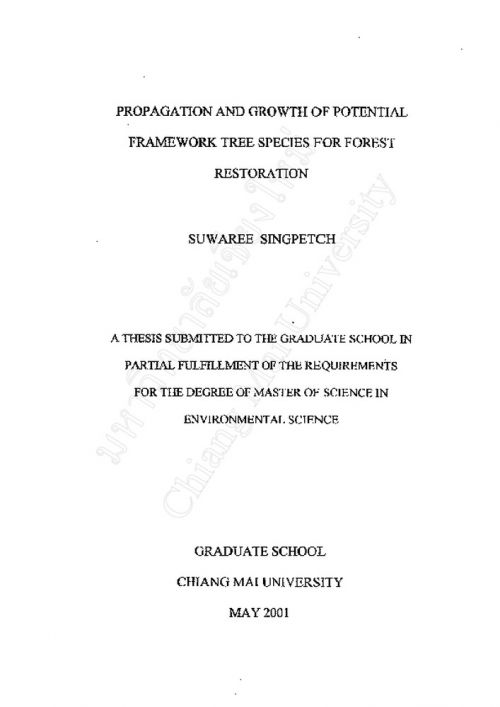Propagation and Growth of Potential Framework Tree Species for Forest Restoration

ABSTRACT: One of the current major problems in Thailand is deforestation. Deforestation causes depletion of soil, land, water and biological resources (especially loss of biodiversity). Restoring forest, by planting native tree species, can help promote biodiversity recovery. Successful restoration largely depends on the availability of good planting stock. Producing high quality planting stock can be achieved by seed germination or by vegetative propagation. This research was conducted at the Forest Restoration Research Unit Nursery (FORRU-CMU), Doi Suthep Pui National Park, northern Thailand. Seed of 9 species: i) Albizia chinensis (Obs.) Merr. (Leguminosae, Mimosoideae), ii) Terminalia alata Hey. Ex. Roth. (Combretaceae), iii) Bauhinia variegata Linn. (Leguminosae, Caesalpinioideae), iv) Aporusa villosa (Lindl.) Baill. (Euphorbiaceae), v) Macaranga denticulata (Bl). M.-A. (Euphorbiaceae), vi) Rhus chinensis Mill. (Anacardiaceae), vii) Ficus abelli Miq viii) Ficus glaberrima Bl. var. glaberrima, and ix) Ficus hirta Vaahl. var. roxburghii (Miq) King (Moraceae), all of which are difficult to propagate in the nursery, were collected in Doi Suthep-Pui National Park. Six different pre-sowing treatments were used (4 levels of temperature and two methods of scarification by hand and conc. H2SO4). For species number i-vi, and 5 treatments for Ficus spp., seeds were sown in baskets in a medium consisting of 50% sand and 50% rice husk. The treatments were replicated in 3 randomised complete blocks. After germination, seedlings were transferred into Rex trays with a medium consisting of forest soil and organic matter. Two fertilizer treatments Osmocote (slow release granule) and soluble NPK: 15:15:15 was applied. These treatments were replicated in 2 randomized complete blocks. Physical and morphological characteristics, such as height, diameter were measured.
Scarification by hand was the best treatment for Albizia chinensis and Bauhinia variegata, increasing percent germination to about 78 and 63% respectively. Treating seeds with conc. sulphuric acid was the best treatment for Rhus chinensis achieving a percent germination of 68%. Soaking seeds in water at 27 degrees centigrade maximized germination of Aporusa villosa and Ficus abelli seeds (61 and 34% respectively). Almost all seeds were killed when treated with hot water 80-100 degrees centigrade. The best fertiliser for Albizia chinensis and Terminalia alata was regular NPK and the best fertiliser for Bauhinia variegata and Aporusa villosa, Rhus chinensis was Osmocote.
Growth in terms of height, diameter, numbers of leaves and health score was monitored every 45 days of 4 species such as Albizia chinensis, Bauhinia variegata, Aporusa villosa and Terminalia alata. RGR (Relative growth rate) of height and diameter of seedling almost were high in first three months (June-August) after transferred into REX trays and reduced in 6 months (December). It indicated that the seedling grown well in rainy season.
